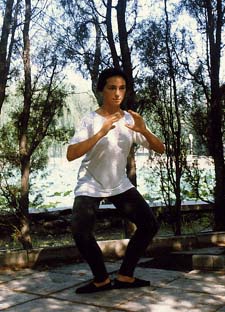"The Way of Qigong"
![]()
![]()
![]()
![]()
For information, email me at:
You are visitor
number:
The Way of Qigong
Since ancient times in China, techniques have been developed to heal all types of illness, to re-harmonise the body, and to increase the vital energy of the individual. The collection of these techniques, in modern times, has been called 'Qigong'.
This name has a very wide and profound significance; to understand it completely we need to analyse another: 'gongfu'. Gongfu is a term which means to obtain something through applying yourself, through constance and patience (where 'gong' means 'work requiring effort, thereby meritorious', and 'fu' means 'a grown or mature man, a Master'). In the term Qigong, we have the same 'meritorious work' applied on the Qi (meaning vital energy, breath or breathing).
Based on the close correlation between spirit and body, a physical and mental practice has been developed that, strengthening the healthy organism and curing the sick one, helps the circulation of the vital energy in us, through the cooperation of body, breathing and mind. This cooperation is fundamental: the body, the breathing, the mind, the energy, the spirit, ... are elements, expressions of a unity: the human being! Each of these elements is capable of interacting with the others, to influence and modify the others. The organism therefore, as an organic complex, made up of each of these elements, needs a corresponding complex of practices and 'gymnastics' to stimulate and control its health, whether physical (of the body and the breathing), whether mental, energetic and spiritual. Qigong is all of this!

Qigong is the art of cultivating Qi, increasing it and strengthening it, through external and spiritual techniques: breathing, posture and movement, mental concentration and meditation. The complex of its techniques has been designed and developed over thousands of years, with the scope of promoting and maintaining good health, promoting longevity, strength and knowledge, thereby achieving both physical and spiritual fulfillment. It is an important part of Traditional Chinese Medicine (TCM). The fundamental structure of Qigong's methods of practice and therapy, is in fact that of TCM, which has at its base the same principles and system of interpretation and diagnosis: the concept of energy (Qi), the law of Yin/Yang; the principle of the five movements, energy levels, meridians, etc. However, it differs from TCM when one defines the techniques and aims regarding practice on oneself, and those regarding therapy on others. In fact the aspects of Qigong considered as part of TCM, are only a small part of the philosophical, cultural and technical world that is at the base of Qigong practice and therapy.
From a therapeutic point of view, the cultural and technical foundation of the "work on Qi" is based on the 'Peoples Medicine' and its historical development. The Peoples Medicine is still practiced today, in its traditional form, by the Qigong masters in the countryside and villages, it is based on a real personal sensitivity and on the capacity to interact with the outside world and other people on an energetic level ... all of this started long before the real indoctrination of what has become Traditional Chinese Medicine, in use in hospitals and all around the world. As far as deeper personal practice goes, the foundations are those which combine the ancient methods of Taoist longevity, the techniques of interior practice used in the temples by Buddhist monks for increasing spiritual consciousness, and of martial arts practitioners for a deeper preparation which was made up of a cooperation of body - breathing - mind through the same "work on Qi".
Qigong provides the practitioner with a great tool for knowledge and health, both for himself and for others, from the point of view of personal practice and of therapy: it promotes the development of a more subtle and powerful awareness of Qi. When Qi is consciously directed in ones own body or that of another, it helps to heal by eliminating blocks, stagnation and weak points in the network of vessels and channels which make up the energy system. The exercises practiced provide a conscious directing of the vital force which can be directed in every cell of ones body, or projected externally through hands, eyes and the mind towards another individual, until it becomes a true conscious pranic-healing: a therapy characterised by the ability to harmonise and heal.
================================================
